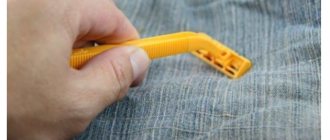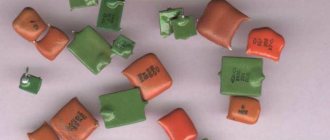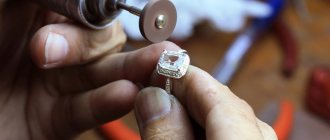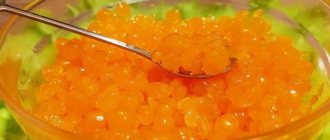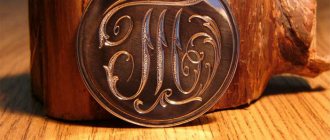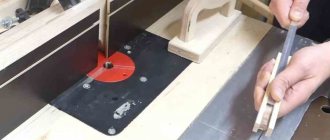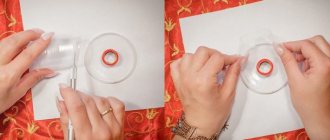By learning how to do gilding at home, which is not as difficult as it might seem at first glance, you can give a second life to your favorite copper and silver jewelry. Products made from gold have been very popular among both women and men for many years. To own such products without significant costs for their acquisition, it is enough to master the technology of gilding.
Both non-ferrous alloys, steel or cast iron can be plated with gold
What metal products can be coated with gold plating?
The most common process is gilding silver, but gold plating can be applied to the surface of other metals. Thus, gilding can be applied to products made of copper, brass and zinc, as well as iron and steel, etc.
There is no clear answer to the question of how to gild metal at home. It all depends on what metal products need to be subjected to such processing. The choice of gilding technology carried out at home is also influenced by the result that needs to be achieved.
With the help of gilding you can give ordinary things a completely different look.
Various methods can be used to gild metal, the most common of which are:
- rubbing the surface of the product with a solution of gold chloride;
- gilding, performed by immersing the product in a solution with a zinc contact;
- galvanic gilding.
Each of these methods of gilding, performed at home, requires the use of certain chemicals, tools and equipment.
Gilding at home
When using gilding technology, you can restore the former attractiveness of almost any jewelry made of copper or silver. Products with gilding are used in a variety of ways, most often they become decoration.
Gilding at home can be carried out using a variety of technologies. You can coat items made of silver or other alloys with gold, the main thing is to know all the features of the process.
Restoring gilding is best done at home using special substances and equipment.
Gilding at home
Various gold plating techniques
The quality of the resulting surface largely depends on the characteristics of the technology used. The most widespread are the following:
- Electroplating method: gold plating.
- Use of special chemicals.
- Mechanical method of applying the required substance.
In each case, certain tools and chemical reagents are used.
At the same time, some technologies are suitable for coating chains at home, others for processing other products for their intended purpose.
Mechanical methods of gilding
Gold plating is characterized by certain qualities that make the product more attractive and resistant to environmental influences. Mechanical application of gold plating is carried out extremely rarely, since it is quite difficult to achieve uniformity of the surface layer. The features of the technology under consideration include the following points:
- For such gilding, a special paste is used. It can be prepared in a specialized store or made with your own hands. The composition of the paste may vary significantly, which is worth considering.
- The layer obtained by using the mechanical method of gilding at home has a small thickness. That is why the resulting coating will not last for a long period.
- Common ingredients include yellow blood salt, chalk powder and cream of tartar.
- It is recommended to mix the paste with water to obtain a homogeneous paste, which is rubbed into the surface using a woolen cloth.
- Before gilding at home, the surface must be degreased. Special compounds are also used for this.
- The gilding paste should be applied in an even layer; when rubbing, care should be taken to ensure that the substance does not get on exposed areas of the skin.
Manual gold plating
Mechanical technology is quite complex to implement. As a rule, it is used if you need to cover only part of the product at home. This is due to the fact that other coating technologies involve complete immersion of the product in a special solution.
Preparation of solution for gilding
The solution for gilding at home should be prepared with extreme care. This is due to the fact that when substances come into contact, a chemical reaction is formed, which can lead to the appearance of harmful emissions. To create the required composition, the following components can be mixed:
- Chlorine gold.
- Salt.
- Potassium cyanide.
- Soda and distilled water.
This composition is most suitable for processing ordinary metal. Gold plating on a silver surface at home can be done by creating the following composition:
- Chlorine gold.
- Potassium carbonate.
- Table salt.
- Ferrous sulfide potassium.
All elements are mixed in water until a homogeneous consistency is obtained. You should work exclusively in protective equipment; contact of the substance with open areas of the body or in the respiratory tract is not allowed.
Preparation and use of gold chloride
To gold-plate metal, a solution called gold chloride is often used. To prepare such a solution, gold is dissolved in “aqua regia,” which is a mixture of hydrochloric and nitric acids. Hydrochloric and nitric acids are taken in a ratio of 3: 1. Gold is placed in this composition, and then the liquid is evaporated. The procedure for evaporating liquid from such a solution should be carried out very carefully so as not to cause burns to the skin and respiratory tract. The dry substance remaining after evaporation is precisely gold chloride.
When evaporating, you need to separate the open fire from the container with the solution, for example, by making a layer of asbestos chips poured into a separate container
Before using gold chloride for gilding, it must be mixed with a solution of potassium cyanide and washed chalk, resulting in a paste-like mass. Using a brush, this paste is used to cover the product, after which it is left for some time, and then thoroughly washed and polished.
To gild steel, gold chloride is mixed with ether. The product coated with this composition is left for some time until the ether has completely evaporated, and then the treated surface is simply rubbed with a cloth to impart a golden shine.
Using gold chloride, previously mixed with ether, various inscriptions and patterns can be applied to a metal object. In order to carry out this procedure, a quill pen is dipped into the resulting solution and the required inscriptions and patterns are made, which, after evaporation of the ether and polishing, will sparkle with a golden sheen.
Large surfaces are covered with gold using a soft brush
As mentioned above, gold plating is often applied to silver, for which gold chloride can also be used. To perform chemical gilding of products made from this metal, it is necessary to prepare a mixture that includes the following components:
- gold chloride – 10 grams;
- potassium cyanide – 30 grams;
- table salt – 20 grams;
- soda – 20 grams;
- water – 1.5 l.
Chemical gilding, which must be applied to silver, can also be performed using a mixture of:
- gold chloride – 7 grams;
- potassium ferric sulfide – 30 grams;
- potassium carbonate – 30 grams;
- table salt – 30 grams;
- water – 1 l.
The procedure for sputtering a layer of gold onto a metal surface using chemical solutions is performed in the following sequence.
- The product being processed is pre-calcined.
- The surface of the object is etched first with a solution of sulfuric acid and then with nitric acid.
- The pickled product is momentarily dipped into a mixture consisting of sulfuric, nitric and hydrochloric acids.
- After treatment in a mixture of acids, the product is rinsed with water, then immersed in mercury and finally in water, where it is kept for 30 seconds.
- After a container of water, the product is placed in a solution for gilding, kept for the required time, then washed with water and dried in sawdust.
Various ways to apply gold plating at home
Gilding at home is carried out in two ways: electrolytic (galvanic) and chemical.
To coat products with gold, reagents are required that are not available on the market: potassium cyanide, nitric and hydrochloric acids.
Special equipment is also required: electrolytic baths and a direct current source. The gilding process is quite labor-intensive and requires skill, accuracy and some experience.
Chemical method
A) Chemical gilding is the process of applying gold chloride to the metal from which the product is made.
Gold chloride is prepared as follows: the metal must be forged into foil and crushed into small pieces, immersed in a mixture of nitric and hydrochloric acids (in the so-called aqua regia).
You need to take 30 g of concentrated hydrochloric acid and 10 g of concentrated nitric acid. For 1 g of gold there should be 10 ml of solution.
Applying gold plating at home
Dissolution must take place in a porcelain bowl; the process can last from several hours to 2-3 days. When the metal is completely dissolved, it is necessary to evaporate the mixture in a water bath at 70-80 degrees until a viscous golden liquid appears. When evaporating, the solution is stirred with a glass rod.
To prepare the mixture for gilding, you will need:
- Hot purified (distilled) water (50-60 degrees) in a volume of 2 liters.
- 15 g of gold chlorine salt syrup.
- 65 g each of potassium carbonate (potash) and highly purified sodium chloride (Extra salt).
Before applying gilding, the surface of the object must be degreased with 10-20% sodium hydroxide or by boiling in a soda solution. Next, the product is washed in a 25% solution of hydrochloric acid, i.e., pickled. After degreasing, it is necessary to rinse the item in water.
Next, the product for gilding is immersed in a prepared mixture of hot water, potash, sodium chloride and gold chloride. The object is touched with a zinc rod, after some time it becomes gold-plated. After this, it is removed and washed, wiped dry and polished with woolen cloth.
B) In addition to the chemical gilding method, the rubbing method using paste is used. With this method of applying gold plating, the coating layer is thinner. The composition of the rubbing paste includes yellow blood salt (potassium hexacyanoferrate [II]), cream of tartar, chalk powder, and gold chloride.
To make 100 g of paste, take 55 g of chalk, 5 g of creamtartar, 30 g of yellow potassium hexacyanoferrate and 10 g of gold chloride, and mix the ingredients. The resulting paste is diluted with water until a paste forms. Rub the fat-free product with this mixture using woolen cloth.
C) There is a third coating method. To do this, 10 g of gold is dissolved in a mixture of nitric and hydrochloric acid, water - take 25 g of all components. Add 300 g of potash (potassium carbonate) to this composition. Prepare a cauldron in which water (2 liters) is boiled, pour this mixture into it. Boiling continues for 2 hours.
Jewelry that needs gilding is calcined and etched first with sulfuric acid, then with nitric acid.
The product is then wrapped with brass wire (an alloy of zinc and copper), and immersed for a moment in a mixture of nitric, sulfuric and hydrochloric acids.
Then the objects are rinsed, then they are alternately loaded into mercury, and then into water. After half a minute, they are dipped into the prepared liquid, washed, and dried in hot sawdust.
Product with gold plated
1) Iron and steel.
To gild steel and iron products, you need to dissolve gold chloride syrup in ether. The resulting composition, applied to a cloth, is used to cover and rub the surface of an object made of steel or iron. Then the ether evaporates, but the gold remains.
If it is necessary not only to gild an item, but to make a pattern on it, then moisten a pen in a mixture of ether and gold chloride and rub it over the item.
It is advisable to cover the surface with copper before gilding objects made of iron, steel, tin, zinc, since gilding fits better on it.
2) Zinc items.
Coating of zinc products is carried out by rubbing them with paste. It is prepared from 60 g of potassium cyanide, 20 g of gold chloride and 100 g of water - these ingredients are mixed. 5 g of cremortartrate and 100 g of calcium carbonate powder (chalk) are added to this solution. The resulting composition is applied using a brush or brush.
3) Silver.
To coat silver jewelry, there are two options for the solution in which objects are immersed:
- 10 g of gold chloride, 30 g of potassium cyanide, 20 g of soda and sodium chloride, one and a half liters of water.
- 7 g of gold chloride, 30 g of potash, yellow potassium hexacyanoferrate and sodium chloride, liter of water.
While immersing the product, you need to touch it with a zinc stick and it will begin to be covered with gold. After this, the object is removed from the solution, washed and wiped, and polished with a woolen rag.
4) Brass.
Gold chloride (2 g) and potassium cyanide (32 g) are dissolved in 0.5 liters of water. Meanwhile, caustic potassium (6 g) and sodium phosphorus salt (10 g) are dissolved in another one and a half liters of water. Mix both solutions and boil.
Electroplating
There are two ways:
- Three solutions are prepared: 60 g of sodium phosphate with 700 g of water; 2.5 g of gold chloride and 150 g of water; 1 g potassium cyanide and 10 g sodium sulfate with 150 g water. The first two solutions are mixed, the third is added last. Temperature - 50-60 degrees. The anode is made of platinum. When the electrolyte solution is depleted, gold chloride is added.
- Bath according to Zelmi: mix 1 g of potassium hexacyanoferrate (yellow) and sodium carbonate with 30 g of water, heat in a porcelain cup. Add gold precipitated with ammonia to the mixture. Boil for 10-12 minutes. When water evaporates, it is added and a Daniel element current is passed through the solution. Exposure time is 15-16 hours.
Gilding methods at home are labor-intensive and not always available. The preferred method is chemical gilding or rubbing.
We recommend other articles
Application of zinc contact
To obtain a thicker gold-plated layer, a zinc contact is used. Using this method, you can, for example, coat silver with a layer of gold. For gilding, a composition is prepared from the following components:
- gold chloride – 15 grams;
- carbonic potassium salt – 65 grams;
- yellow blood salt – 65 grams;
- table salt – 65 grams;
- water – 2 l.
It will take some time to dissolve all components of the composition
Products made of copper and brass are plated with gold in a solution of the following composition:
- gold chloride – 2 grams;
- caustic potassium – 6 grams;
- potassium cyanide – 32 grams;
- sodium phosphorus salt – 10 grams;
- water – 2 l.
Objects on the surface of which it is necessary to apply a layer of gilding are thoroughly cleaned of dirt and grease, then they are placed in a preheated gilding composition. The products already there are connected to a zinc rod, which acts as a contact.
Compositions of degreasing solutions
In order for the gilding applied to the surface of products made of steel, zinc and tin to be of high quality and have good adhesion, they must be subjected to a copper plating procedure before gilding.
How to gild metal at home
Products made of gold-plated metals have always been very popular. When handled with care, they looked beautiful and were inexpensive.
Therefore, many could afford to change jewelry often and match it to the appropriate outfits. However, over time, the gilding wore off, and gilding in a jewelry workshop costs even more than the product itself.
Therefore, many people think about how to gild metal at home.
Technology of coating objects with gold leaf
Gold coating of plastic, wood, metal and other materials is carried out using the thinnest sheets - the thickness of gold leaf (cladding) is 0.13-0.67 microns.
In the old days, gold leaf was made by hand, today special equipment is used. Depending on the thickness of the sheet, free and transfer (on silk paper) gold leaf is distinguished.
It is very difficult to work with the first one - the slightest breath interferes with the process.
The finished material is stored in little books - each of the 60 sheets is covered with paper. Applying gold leaf is a painstaking process.
The technology is based on the ability of gold rolled out from a sheet to be attracted to the surface at the molecular level.
There are two techniques for gilding with gold leaf: glue (for polyment) and oil (for Mordan varnish). In the first case, a glossy surface is obtained, and in the second, a matte surface.
The adhesive method is used when carrying out interior work.
Amalgam gilding
The amalgam (fire) gilding method is another ancient method of applying precious metal. It has a high degree of durability, but the process itself is extremely toxic and is not used today.
The essence of the method is the molecular penetration of a precious metal dissolved in mercury into the base (during the firing process, the mercury evaporates, but the gold remains).
An example of such work is the dome of St. Isaac's Cathedral in St. Petersburg.
